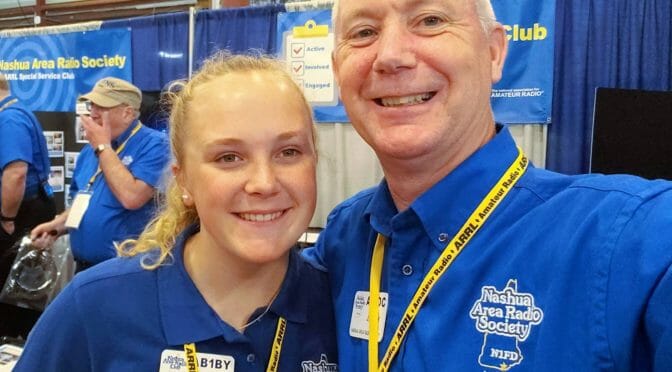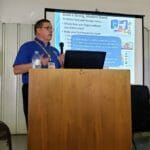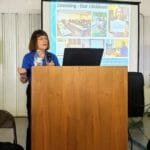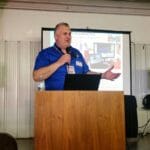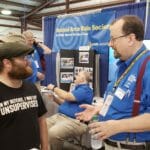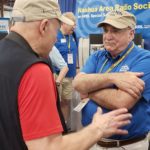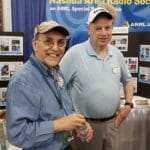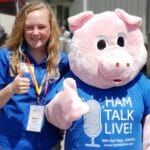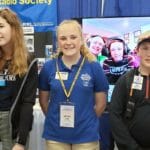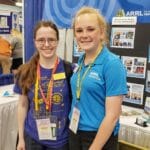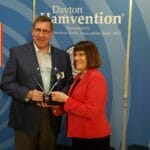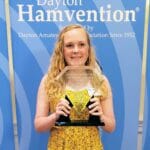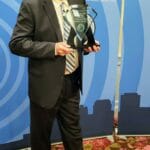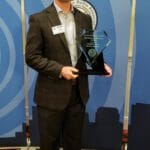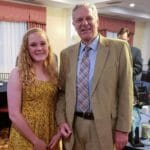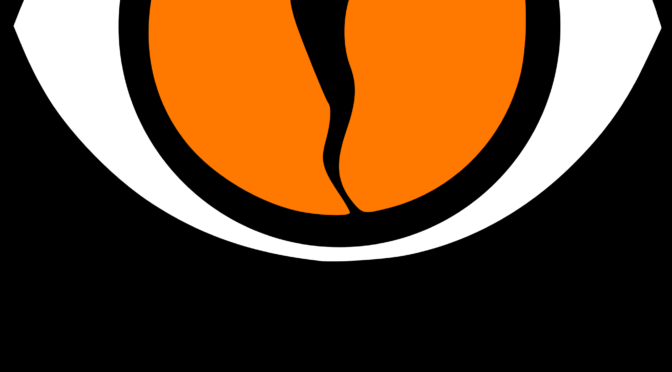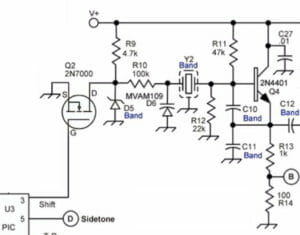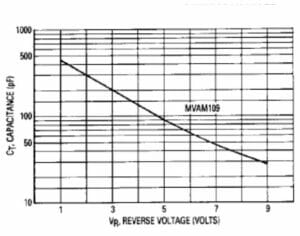by Jamey, AC1DC and Abby, AB1BY
Abby, AB1BY and I were lucky enough to attend the Dayton Hamvention this year and see our club, the Nashua Area Radio Society accept the Club of the Year award. Here’s our recap of what it was like for each of us as first-time participants and Hamvention Newbies.
The Drive
On Tuesday evening I was picked up by Fred (AB1OC) and Anita (AB1QB) and we started our drive long drive through the night to Dayton. It was only about 15 minutes into our ride when I realized I’d left my wallet at home. We turned back and I tore the house apart in a frantic rush as I looked for my wallet! No luck, so I went back to the truck and looked through my backpack… and there it was. Not the best start to the trip. We also had trouble with the navigation system and the mobile antenna was not tuning up! Our trip did not seem to be getting off to a good start. We did get everything working properly and we were still in good spirits as we were excited for what was to come. We arrived in Dayton on Wednesday morning and checked into our hotels and got a nap and shower.
Fondue!
We went out on Wednesday evening for Anita’s birthday dinner to the Melting Pot, a fondue place. I have never been to a fondue restaurant and ordering was quite a process – picking cheeses, meats, and desserts. Getting coached through the process, we had our meal ordered and it was fantastic!

Contest University/Booth Set Up
Thursday morning was the start of Contest University at the Crowne Plaza in Dayton. I highly recommend this to anyone going out to Hamvention for the first (or any) time.
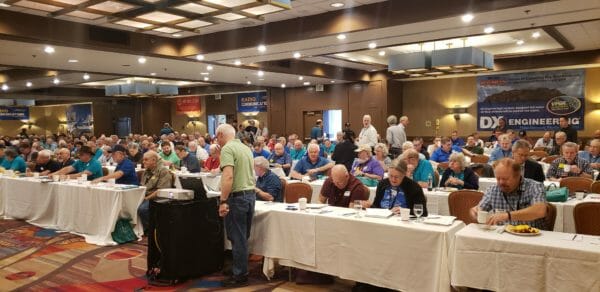
I’m not sure of the exact number, but you can see from the picture there were quite a few people in attendance. The morning was made up of the 3 sessions in which you choose from 4 different topics to attend. There was quite a variety of topics! After the morning session of Contest University, I got my first view of Xenia, where Hamvention was being held, as we went to set up our booth for the next day. Our booth was in a great spot in the Tesla building with all the ARRL booths – prime location! The booth looked great and very professional when we were done thanks to a lot of work put in by Anita (AB1QB). We also got a chance to walk around the buildings a bit and look at the vendor booths as they set up. Fred and Anita took me over to the Heil booth and I got to meet Bob Heil (K9EID)! I also got to play with some fine Begali keys without the crowds and check out the AMSAT booth. AMSAT had a really cool display of module cubesats!

After setting up I headed down to the Cincinnati Airport to pick up Abby (AB1BY). The fun was just beginning!
Abby Arrives
Since Abby had exams on Thursday morning she got to skip the drive and fly out to Dayton – actually Cincinnati, which is actually in Kentucky! This was her first time flying by herself and she was a little worried but had a direct flight from Boston so there wasn’t too much to worry about. She was excited to attend Hamvention but wasn’t really sure what to expect. I picked Abby up at the airport and drove back an hour to Dayton. We had a room in the Marriott and we were on the top floor where you needed your room key to make the elevator go to that floor. Abby was really feeling like a VIP. She also likes that there was also a lounge on our floor where you could get free cookies and drinks. Our room at the hotel was nice as well. Abby liked the view from our balcony. There’s a chalk outline on the pavement that says, “Don’t Let This Be You!”
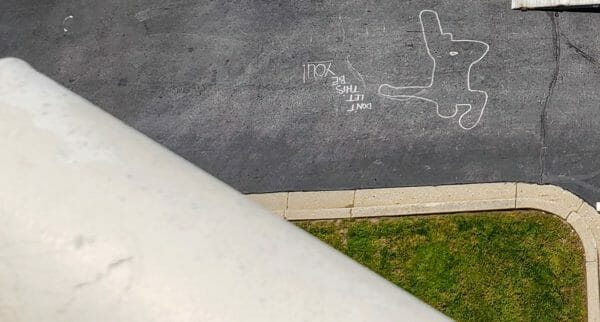
Dayton Hamvention Begins
We woke up very early on Friday morning and had a quick bite at the hotel before heading over to the Xenia Fairgrounds for the first official day of Hamvention. We arrived a little late for our 8:30 am meeting as the traffic and crowds were huge! The NARS booth looked fantastic and we had a lot of people stopping by to check us out. Abby and I did some live-streaming on Facebook and took our audience on a virtual tour of the Tesla building. We also were stopped several times on our walk around the grounds by people who recognized Abby from some of our club videos. She was very tickled to be recognized and have people ask her for a photo with her.
Later in the morning, we headed over to our forum room for the club talk – ARRL Spotlight on Radio Clubs and Mentoring. We had a nice crowd and Fred (AB1OC), Anita (AB1QB), Dave (K1DLM), Scott (NE1RD), Abby (AB1BY) and myself (AC1DC) all spoke on different aspects of the club.
We spent the rest of the day hanging out at the NARS booth and checking out the grounds around Xenia. We loved the fairground food. I got to have a corndog on a stick and Abby tried out the cheesecake on a stick.
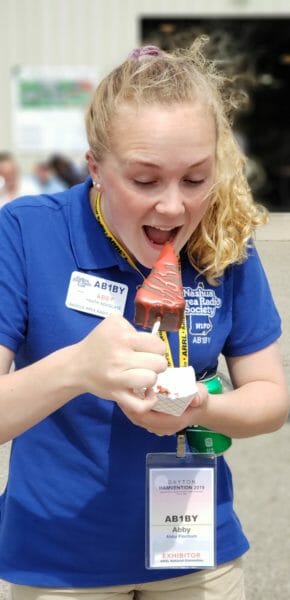
Speaking of food! On Friday night we went to the Top Band Dinner and listened to a talk by Ted Rappaport (N9NB). The food was great and Ted kept us all entertained with his talk.
Crowds and Forums

Saturday morning was another early start for us. We thought it was packed on Friday. Saturday it was mobbed! Huge crowds and the NARS booth was hopping! Luckily we had a large contingent of NARS members to handle the crowds.
Saturday, we also got our first taste of attending the forums. Abby attended the Youth Forum presented by Carole Perry (WB2MGP) and a host of other speakers, including Tamitha Skov (WX6WW)! Abby enjoyed the variety of topics presented from the speakers from around the world. She had a great time seeing and meeting other amateurs that love the hobby. She also won a raffle for $100 from DX Engineering – she has yet to use it!
While Abby was at the Youth Forum I attended the Summits on the Air forum presented by Keith Schlottman (KR7RK) with Craig (N1SFT), Brian (W1BP) and Jerry (K1OKD). This was held in one of the smaller venues on the fairgrounds and it was a full house. Keith did a great job explaining the basics of how SOTA works and he had some really nice pictures of different SOTA activations. I realized how lucky we are here in New England as he mentioned some “summits” or high points had a Wendy’s across the street!
Abby was busy on the forum circuit as she then attended the Young Ladies Radio League (YLRL) forum presented by Marily Melhorn (AF7BI) and Anna Manna (WB1ARU). Abby really enjoyed the presentation and how welcoming everyone was. They also had time at the end to “mingle” which Abby also loved!
Club Of The Year Awards Dinner
Saturday night was the night for the Awards Dinner. We had a lovely meal with other members of the NARS Executive Committee as we anxiously awaited the announcement and Fred’s (AB1OC) acceptance speech.
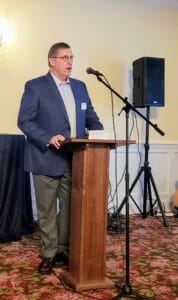
Fred did not disappoint with a very nice speech. Fred is always very willing to give credit to others even when he deserves the credit. He took the crowd through the club’s journey starting back four years ago up to the present. As we sat and listened to Fred talk so passionately about the club it really hit home how much this club has accomplished in such a short time. It really has been a huge group effort under the leadership of a very passionate leader.
After dinner, we all took turns with pictures of the award and with other dignitaries in attendance.
Heading Home
We got a little later start on Sunday and things were winding down at Hamvention. We greeted more people at the NARS booth and attended the ending raffles (with no luck) and the public announcement of all the award winners from the night before. We then packed up the truck and started the long drive home. We were back in Nashua early Monday morning and Abby didn’t miss school – she was thrilled…
We both realize how lucky we are to have attended Hamvention and meet so many people there, to be associated with the best club and to have made so many close friends in the club over the years. This was truly an amazing trip for both of us – something we’ll have memories of for a lifetime – and we want to thank everyone who made this such a wonderful experience.

